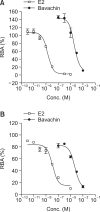Activation of Estrogen Receptor by Bavachin from Psoralea corylifolia
- PMID: 24116293
- PMCID: PMC3792216
- DOI: 10.4062/biomolther.2012.20.2.183
Activation of Estrogen Receptor by Bavachin from Psoralea corylifolia
Abstract
In this study, we examined the estrogenic activity of bavachin, a component of Psoralea corylifolia that has been used as a traditional medicine in Asia. Bavachin was purified from ethanolic extract of Psoralea corylifolia and characterized its estrogenic activity by ligand binding, reporter gene activation, and endogenous estrogen receptor (ER) target gene regulation. Bavachin showed ER ligand binding activity in competitive displacement of [(3)H] E2 from recombinant ER. The estrogenic activity of bavachin was characterized in a transient transfection system using ERα or ERβ and estrogen-responsive luciferase plasmids in CV-1 cells with an EC50 of 320 nM and 680 nM, respectively. Bavachin increased the mRNA levels of estrogen-responsive genes such as pS2 and PR, and decreased the protein level of ERα by proteasomal pathway. However, bavachin failed to activate the androgen receptor in CV-1 cells transiently transfected with the corresponding receptor and hormone responsive reporter plasmid. These data indicate that bavachin acts as a weak phytoestrogen by binding and activating the ER.
Keywords: Bavachin; Estrogen receptor; Phytoestrogen; Psoralea corylifolia.
Figures






Similar articles
-
Psoralidin, a coumestan analogue, as a novel potent estrogen receptor signaling molecule isolated from Psoralea corylifolia.Bioorg Med Chem Lett. 2014 Mar 1;24(5):1403-6. doi: 10.1016/j.bmcl.2014.01.029. Epub 2014 Jan 20. Bioorg Med Chem Lett. 2014. PMID: 24507928
-
Phytoestrogens from Psoralea corylifolia reveal estrogen receptor-subtype selectivity.Phytomedicine. 2010 Feb;17(2):126-31. doi: 10.1016/j.phymed.2009.05.015. Epub 2009 Jul 3. Phytomedicine. 2010. PMID: 19577453
-
Chronic disease management via modulation of cellular signaling by phytoestrogen Bavachin.Mol Biol Rep. 2024 Aug 19;51(1):921. doi: 10.1007/s11033-024-09849-z. Mol Biol Rep. 2024. PMID: 39158613 Review.
-
Bavachin from Psoralea corylifolia Improves Insulin-Dependent Glucose Uptake through Insulin Signaling and AMPK Activation in 3T3-L1 Adipocytes.Int J Mol Sci. 2016 Apr 8;17(4):527. doi: 10.3390/ijms17040527. Int J Mol Sci. 2016. PMID: 27070585 Free PMC article.
-
Molecular mechanisms of estrogen action: selective ligands and receptor pharmacology.J Steroid Biochem Mol Biol. 2000 Nov 30;74(5):279-85. doi: 10.1016/s0960-0760(00)00104-7. J Steroid Biochem Mol Biol. 2000. PMID: 11162936 Review.
Cited by
-
Comparative effects of er-xian decoction, epimedium herbs, and icariin with estrogen on bone and reproductive tissue in ovariectomized rats.Evid Based Complement Alternat Med. 2012;2012:241416. doi: 10.1155/2012/241416. Epub 2012 Nov 7. Evid Based Complement Alternat Med. 2012. PMID: 23227099 Free PMC article.
-
Anti-metastatic effect of GV1001 on prostate cancer cells; roles of GnRHR-mediated Gαs-cAMP pathway and AR-YAP1 axis.Cell Biosci. 2021 Nov 7;11(1):191. doi: 10.1186/s13578-021-00704-3. Cell Biosci. 2021. PMID: 34743733 Free PMC article.
-
The potential health effects of dietary phytoestrogens.Br J Pharmacol. 2017 Jun;174(11):1263-1280. doi: 10.1111/bph.13622. Epub 2016 Oct 20. Br J Pharmacol. 2017. PMID: 27723080 Free PMC article. Review.
-
The Potential Effects of Phytoestrogens: The Role in Neuroprotection.Molecules. 2021 May 16;26(10):2954. doi: 10.3390/molecules26102954. Molecules. 2021. PMID: 34065647 Free PMC article. Review.
-
The Role of Signal Transducer and Activator of Transcription 3 (STAT3) and Its Targeted Inhibition in Hematological Malignancies.Cancers (Basel). 2018 Sep 13;10(9):327. doi: 10.3390/cancers10090327. Cancers (Basel). 2018. PMID: 30217007 Free PMC article. Review.
References
-
- Chang E. C. Charn T. H. Park S. H. Helferich W. G. Komm B. Katzenellenbogen J. A. Katzenellenbogen B. S. Estrogen Receptors alpha and beta as determinants of gene expression: influence of ligand, dose, and chromatin binding. Mol. Endocrinol. (2008);22:1032–1043. doi: 10.1210/me.2007-0356. - DOI - PMC - PubMed
LinkOut - more resources
Full Text Sources
Research Materials

